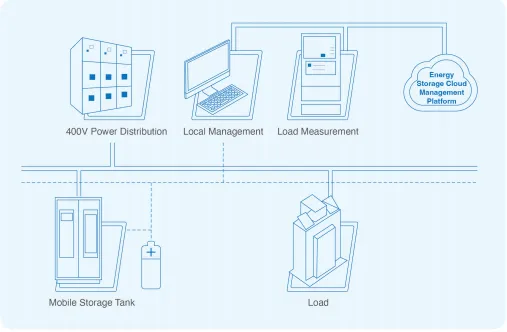
Jul . 03, 2025 13:56 Kembali ke daftar
BMS Energy Retrofitting for Aging Infrastructure
Aging infrastructure poses significant challenges for cities, industries, and institutions worldwide. Outdated systems strain energy resources, inflate operational costs, and contribute to environmental degradation. Retrofitting these structures with advanced technologies like BMS energy solutions, sistem manajemen energi, and smart grid management tools offers a transformative opportunity to enhance efficiency, reduce waste, and future-proof buildings. This article explores how integrating these systems breathes new life into aging infrastructure while aligning with global sustainability goals.

The Role of BMS Energy Solutions in Retrofitting Aging Infrastructure
Building Management Systems (BMS) are the backbone of modern energy optimization. For aging infrastructure, retrofitting with BMS energy technologies provides a centralized platform to monitor, control, and automate critical systems like HVAC, lighting, and power distribution. Older buildings often rely on fragmented, manual processes that lead to energy waste and operational inefficiencies. A BMS energy retrofit replaces these outdated practices with real-time data analytics, predictive maintenance, and automated adjustments.
For example, a retrofitted BMS energy system can detect anomalies in heating or cooling patterns, adjust temperatures based on occupancy sensors, and prioritize energy use during off-peak hours. This not only slashes energy bills by up to 30% but also extends the lifespan of mechanical systems. Moreover, BMS energy upgrades are scalable, allowing facilities to integrate renewable energy sources like solar panels or geothermal systems as budgets permit.
The synergy between BMS energy retrofits and sistem manajemen energi ensures that every watt of power is optimized. By layering these technologies, aging buildings can meet modern energy standards without costly demolitions or rebuilds.
Enhancing Efficiency with Energy Management Systems Dan Smart Grid Management
Energy management systems (EMS) are pivotal in translating raw data from BMS energy platforms into actionable insights. These systems analyze energy consumption patterns, identify waste hotspots, and recommend adjustments to align with sustainability targets. When paired with smart grid management, EMS enables bidirectional communication between buildings and utility providers, creating a dynamic energy ecosystem.
For aging infrastructure, this combination is revolutionary. Smart grid management allows facilities to participate in demand-response programs, where energy usage is adjusted during peak periods to alleviate grid stress. For instance, a retrofitted factory could temporarily reduce non-essential power consumption during a heatwave, earning financial incentives from utilities while preventing blackouts.
Additionally, sistem manajemen energi empower stakeholders to track carbon footprints in real time. By integrating weather forecasts, occupancy trends, and energy pricing data, EMS optimizes consumption without compromising comfort or productivity. This is particularly valuable for hospitals, universities, and industrial complexes that operate 24/7.
The integration of smart grid management also future-proofs infrastructure against evolving regulations. As governments impose stricter carbon taxes and emissions caps, retrofitted buildings with EMS and BMS energy systems will remain compliant and competitive.
Integrating Smart Grid Management into BMS Energy Retrofits
The marriage of smart grid management Dan BMS energy retrofits creates a resilient, adaptive energy network. Older infrastructures often lack the flexibility to respond to grid fluctuations or renewable energy inputs. Retrofitting with smart grid management capabilities bridges this gap by enabling two-way energy flows and storage optimization.
For example, a retrofitted office building with solar panels can use BMS energy controls to store excess solar power in batteries during the day and draw from them during peak evening hours. Smart grid management ensures this stored energy is either used onsite or fed back into the grid for revenue generation. This reduces reliance on fossil fuels and stabilizes energy costs.
Another advantage is disaster preparedness. Aging infrastructures in regions prone to power outages can use smart grid management to isolate from the main grid during emergencies and operate autonomously via backup generators or renewables. BMS energy systems then prioritize power for critical operations like elevators, security systems, and medical equipment.
This integration also enhances tenant satisfaction. Modern occupants expect sustainable, tech-enabled spaces. Retrofitted buildings with smart grid management Dan BMS energy features attract eco-conscious tenants and command higher rental premiums.
FAQs: Addressing Key Questions About BMS Energy Retrofits and Smart Grid Management
How Does a BMS Energy Retrofit Improve Cost Savings?
A BMS energy retrofit reduces operational costs by automating energy-intensive processes and eliminating waste. Real-time monitoring identifies inefficiencies, while predictive maintenance prevents costly equipment failures. Combined with smart grid management, facilities can capitalize on lower energy rates during off-peak hours and earn incentives for grid support.
Can Energy Management Systems Work with Existing Infrastructure?
Yes! Energy management systems are designed to integrate seamlessly with legacy infrastructure. Retrofitting involves upgrading sensors, controllers, and software without replacing entire systems. This minimizes downtime and upfront costs while delivering immediate energy savings.
How Does Smart Grid Management Enhance Sustainability?
Smart grid management reduces reliance on non-renewable energy by optimizing the use of solar, wind, and stored power. It also balances supply and demand across the grid, lowering overall carbon emissions. For retrofitted buildings, this means a smaller environmental footprint and alignment with ESG goals.
Are BMS Energy Retrofits Secure Against Cyber Threats?
Modern BMS energy systems prioritize cybersecurity with encrypted data transmission, multi-factor authentication, and regular software updates. When integrated with smart grid management, these protocols ensure safe communication between building systems and external grids.
What ROI Can I Expect from a BMS Energy Retrofit?
Most projects achieve a return on investment within 3–5 years through energy savings, tax incentives, and increased property value. Facilities with smart grid management capabilities often see faster paybacks due to revenue from demand-response programs and renewable energy sales.
Retrofitting aging infrastructure with BMS energy, sistem manajemen energi, and smart grid management is no longer optional—it’s a strategic imperative. These technologies breathe new life into outdated buildings, slashing costs, boosting sustainability, and enhancing resilience. As global energy demands rise, the fusion of intelligent automation and grid adaptability will define the future of infrastructure. By investing in these retrofits today, organizations secure a competitive edge while contributing to a cleaner, smarter tomorrow.
-
Wireless DC Charging: The Next Frontier in Contactless EV Power Delivery
BeritaAug.04,2025
-
Hybrid BMS Energy Controls: Integrating Renewable Energy Sources
BeritaAug.04,2025
-
Blockchain for Secure and Decentralized EMS Power Systems
BeritaAug.04,2025
-
AI-Driven for Smart Grids: Energy Management System (EMS)
BeritaAug.04,2025
-
Advanced Distribution Management System (ADMS) Energy
BeritaAug.04,2025
-
5G-Enhanced BMS Energy Savings: Ultra-Low Latency Control
BeritaAug.04,2025























